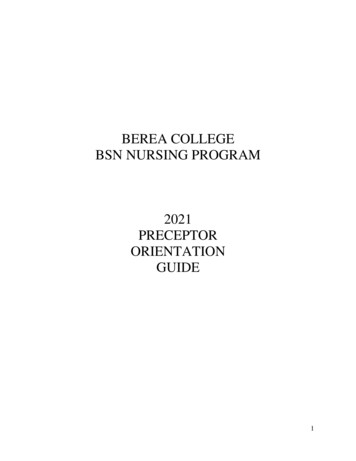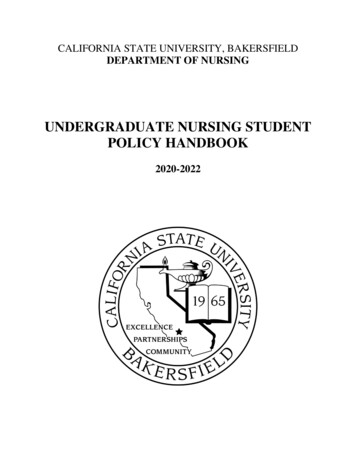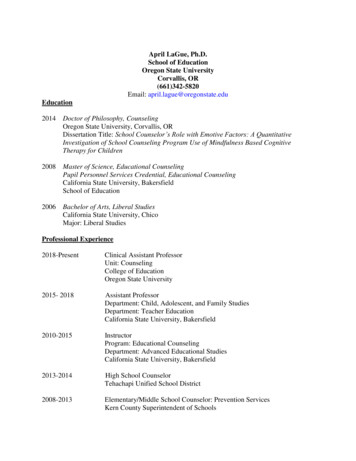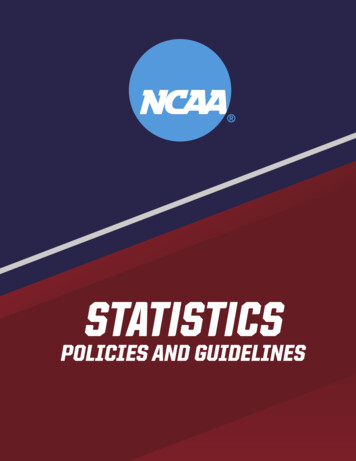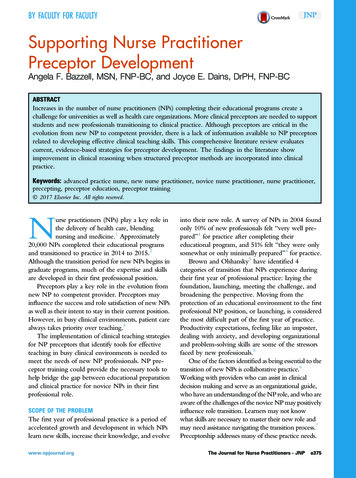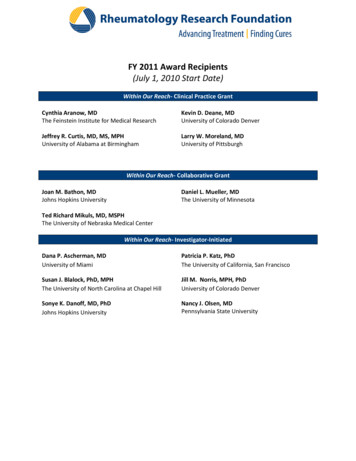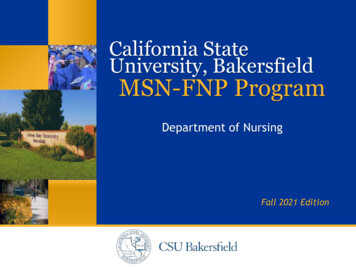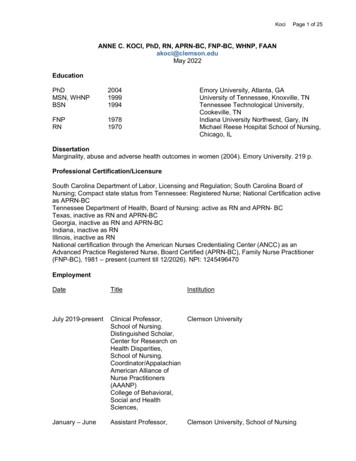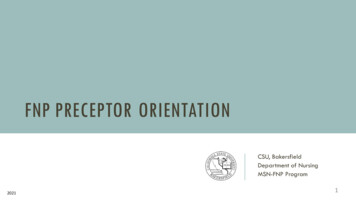
Transcription
FNP PRECEPTOR ORIENTATIONCSU, BakersfieldDepartment of NursingMSN-FNP Program20211
2
Contents Graduate Nursing Program Overview Family Nurse Practitioner Program Overview MSN/FNP Preceptor Program FormsPlease Note: This document is intended as a brief overview and reference of the MSNFNP Program requirements, student responsibilities, and preceptor responsibilities.Preceptors and students should refer to the Preceptor Handbook for full descriptions.3
GRADUATE NURSING PROGRAM OVERVIEWCSU, BakersfieldDepartment of NursingMSN-FNP Program4
MISSION STATEMENTThe Department of Nursing (DON) at California State University, Bakersfield (CSUB)provides nursing education to undergraduate and graduate students seeking entryinto professional nursing or advanced nursing education. The faculty provides acollaborative, inclusive, and interactive learning environment committed toexcellence in teaching, scholarship, service, and practice. The DON accomplishes themission through collaboration with the communities of interest.The DON fosters an environment that encourages lifelong learning and advancementwithin the profession. Graduates will have the acquired knowledge, skills, attitudes, andvalues essential to the practice of advanced professional nursing.As professional nurses, our graduates will engage in evidence-based practice in aninterprofessional healthcare environment. In recognition of the health needs of amulticultural society, advanced professional nurses who are graduates of CSUB willaddress healthcare issues and needs of their community.5
VISION STATEMENTThe CSUB DON pursues innovativeways to advance nursing practiceand address the growingcomplexities associated withcreating a healthier population inCalifornia’s Central Valley.VALUES STATEMENTThe Department’s values align with thoseof the university, including academicexcellence, freedom of inquiry andstatement, global awareness and culturalsensitivity, diversity, honesty and fairness,democratic governance, communityengagement, and personal responsibility.The DON embraces professionalism anda respect for the inherent ethical valuesof altruism, autonomy, human dignity,integrity, and social justice asfundamental to the discipline of nursing.6
GRADUATE PROGRAM DESCRIPTIONThe purpose of this master’s program is to prepare nurses with advanced nursing theory and clinical experiences in theadvanced practice nursing role of Family Nurse Practitioner (FNP). Students are prepared to assess the health needs andhealth risks of all family members, apply family theories, and analyze legal, ethical, economic, leadership, and professionalissues pertinent to nurse practitioners. Graduates from this program will be qualified to practice in primary carepractice settings within the changing patterns of health care; assume leadership roles in multidisciplinary health groups; andpractice family nursing in various health care settings. Graduates will be prepared to apply for doctoral programs in nursing.The content of this program includes advanced health assessment, advanced pathophysiology, and advanced pharmacology;analysis, utilization, and evaluation of theories of nursing; research methodology; role development; care of vulnerablepopulations; health care policy and delivery systems; leadership; and application of advanced knowledge in providingnursing care for clients representing a variety of cultural and ethnic backgrounds in both urban and rural community settings.Students complete a culminating experience (comprehensive examination) which demonstrates their competence in the conductof scientific inquiry related to clinical problem solving. Students must complete the requirements for the Master’s degreebefore they can pursue FNP certification from the California State Board of Registered Nursing.The MSN/FNP Option has been approved by the CSU Chancellor’s office and has been accredited by the WesternAssociation of Schools and Colleges (WASC). The Master of Science in Nursing (MSN) program has obtained accreditationfrom the Commission of Collegiate Nursing Education (CCNE) according to their routine procedures. This program has beenapproved by the California Board of Registered Nursing.7
MASTER’S DEGREE PROGRAM OBJECTIVESThe program objectives are to prepare students for graduation who can:1.Expand knowledge and evaluate nursing theories and theories from related disciplines as a basis for advanced roles andnursing practice.2.Utilize nursing concepts, theories, and knowledge to support advanced practice roles and evidence-based nursingpractice.3.Demonstrate expertise in advanced roles in nursing.4.Apply evidence based research findings to advanced roles and nursing practice.5.Utilize the steps of scientific inquiry to evaluate and integrate research, theory, and practice.6.Advance practice through the development and implementation of strategies for improving nursing care and initiatingchanges in the health care system.7.Actively engage in collaborative relationships with other members of the health care team to improve health care andinfluence health care policies.8.Assume responsibility for contributing to the advancement of the nursing profession.9.Utilize technology to enhance the effectiveness of managing client and clinical information.10.Acquire a foundation for doctoral study in nursing.8
FNP PROGRAM OVERVIEWCSU, BakersfieldDepartment of NursingMSN-FNP Program9
The Family Nurse Practitioner Program Overview: Two-year, 5-semester program leads to a Master of Science Degree in Nursing. Upon graduation, students areeligible to apply for state certification as a nurse practitioner.1.The first semester includes Pharmacotherapeutics for Advanced Practice Nursing, Pathophysiology foradvanced practice nurses, and an Advanced Health Assessment course, which prepares them to conductcomprehensive history and physical exams.2.There are four clinical nurse practitioner courses begins in the second through fifth semester. Studentscontinue to take didactic courses at CSUB during the time they are completing their clinical requirements. Clinical Experience:Clinical experience, defined as direct client care to individuals/families and/or communities, is a requiredcomponent of the nurse practitioner curriculum. Clinical experience gives students the opportunity to applytheory in the clinical situation, develop an understanding of the nurse practitioner's role, function as amember of an interdisciplinary team, and demonstrate the ability to mobilize and coordinate availablecommunity resources in the management of client health and illness states. Students develop their clinicalreasoning skills and test their philosophy of practice throughout clinical experience. This opportunity toapply in practice, the theory, research, and technical skills they are learning must be sufficient to enable thestudent to develop the competencies necessary for practice. The FNP Faculty are accountable for the final evaluation of students; however, preceptors are vital membersof the teaching team and are clinically expert individuals with whom students have the opportunity to workwith. 10
FNP PROGRAM OBJECTIVESUpon graduation or entry to advanced practice, the Family Nurse Practitioner should demonstrate competence in thefollowing:1.Synthesize theoretical, scientific, and contemporary clinical knowledge for the assessment and management of bothhealth and illness states for the purposes of health promotion, health protection, disease prevention, and treatment ofthe individual, the family, aggregate groups, and the community.2.Demonstrate a personal, collegial, and collaborative approach which enhances the Family Nurse Practitioner’seffectiveness in patient care.3.Function as a licensed independent practitioner by using best available evidence to continuously improve quality ofclinical practice.4.Demonstrate a commitment to the implementation, preservation, and evolution of the Family Nurse Practitioner role.5.Implement clinical reasoning and build collaborative, interdisciplinary relationships to provide optimal health care tothe patient.6.Oversee and direct the delivery of clinical services within an integrated system of health care to achieve improvedhealth outcomes for patients, communities, and systems.7.Ensure quality of health care through consultation, collaboration, continuing education, certification, and evaluation(eligible for state and national certification upon completion of the program.8.Provide culturally competent care, deliver patient care with respect to cultural and spiritual beliefs, and make healthcare resources available to patients from diverse cultures.11
CURRICULUM TIMETABLE12
GUIDELINES FOR STUDENT PROGRESSNote to Preceptors: A copy of the student's minimum clinical requirements is provided to you forinformational purposes. The student is responsible for working with you and your office staff in choosingappropriate patients to meet these requirements. The number of patients seen will depend upon thecomplexity of the patients' problems and the students' familiarity with the condition. Students are expectedto be thorough and complete. Student productivity is expected to increase as the student progresses in theprogram. Typically students see an average of 2-3 patients per day during their first semester (N6321), 45 patients per day during the second semester (N6331), and 5-6 patients per day in subsequentsemesters (N6341, N6531).(P 17-20)13
STUDENTRESPONSIBILITIES Patient encounters in category 1 will not be counted in the clinical requirements. Only patient contacts in categories 2 through 4 will be accepted as meeting the requirements. It is expected that students to complete these requirements starting the second semester. It is anticipated that students may see fewerpatients in the beginning semesters but considerably more patients in the last two semesters as their efficiency and ability to managemore complex patients improves.14
PRECEPTOR PROGRAMCSU, BakersfieldDepartment of NursingMSN-FNP Program15
Preceptor Policies and ProceduresDefinition:The Graduate Preceptor Program at California State University, Bakersfield (CSUB) is a component ofthe Nursing Program that includes a teaching strategy designed to provide students with learningexperiences that are guided by a Primary Health Care Provider who may also be an expert in his or herarea of specialty.I. Preceptors shall be licensed as a Family Nurse Practitioner or Physician in the state ofCalifornia and be employed by a CSUB affiliated health care facility for at least oneyear.II. Students shall be enrolled in the designated CSUB course in which he/she is assigned to apreceptor and will not be compensated by the clinical facility where the clinical rotationoccurs.III. The Preceptor Program files shall be kept in the CSUB Nursing Department office andincludes information for the designated semester/year assignedIV. The Preceptor Handbook serves as the written guidelines regarding the role andresponsibilities of Nursing Faculty (Course Team Leader, Clinical Instructor), Preceptor, andStudent and the required forms.(based on California BRN Regulations for Preceptorships)16
ROLE & RESPONSIBILITY: PRECEPTOR1.Assists the student by arranging opportunities and resources to obtain learningexperiences appropriate to the course and individual learning objectives.2.Assists the student in his/her orientation to the agency. This includes philosophy, policies, andprocedures of the agency and expectations of the student. Examples include dress code,special equipment, emergency situations (fire, disaster, and codes), documentation, charting,writing prescriptions, medication administration, access to computer system for nursingdocumentation and retrieval of information, telephone and facsimile use.3.Maintains sufficient availability during the same schedule as the student. The graduate student willneed to match the preceptor schedule rather than the preceptor accommodating the student’sschedule. In rare situations, the preceptor may designate another agency member to assist thegraduate student. Designee must be a FNP or MD with sufficient experience to assist the graduatestudent.4.Signs the clinical timesheet verifying student attendance. Provides ongoing and culminatingevaluation of the student’s performance to the student and the assigned Clinical Instructor (seeforms: Preceptor Evaluation of Student Performance; Clinical Performance Evaluation Tool).17
ROLE & RESPONSIBILITY: PRECEPTOR (CONTINUED)6.Meets with the student during or at the end of each shift to discuss/document studentachievement or lack of achievement of clinical objectives and individual student learningobjectives. This is documented on the Individual Student Objectives and LearningContract.7.Notifies the student and Clinical Instructor at any time during the course that clinicallearning is not being met or when a student is not making sufficient progress towardachieving the course objectives.Evaluates the student’s learning, in conjunction with the Clinical Instructor, based on thecourse and learning objectives.8.9.Submits a completed evaluation of the course (Preceptor Evaluation of Clinical PreceptorExperience) to be filed in the CSUB DON as required by the Board of RegisteredNursing (see forms).10. Submits a completed Preceptor Profile Form which includes information on his/hereducation, qualifications and work experience and Confirmation of Agreement ToPrecept to be filed in the CSUB DON as required by the Board of RegisteredNursing (see forms).18
TIPS FOR PRECEPTORS1.Be patient, patient, patient.2.Keep your hands behind your back and lips sealed. Allow the student to make the decisions as you watch, unless he/she isproceeding in an unsafe manner.3.Use guided questioning with the student, allowing the student to give the rationale for an action. Talk the student throughdecisions and procedures, but ask them, “what do you think you should do?” After they answer, ask them for their rationale. Thishelps them with their critical thinking ability. Even though it puts them on the spot, in the long run they will benefit.4.Do not be too quick to give the students answers to their questions (Unless it is a life-threatening situation); instead, help them todevelop their clinical reasoning skills.5.Review the course objectives for each course and help the student seek appropriate clinical skills/experiences. Not all studentshave had the opportunity to perform every advanced nursing procedure.6.Encourage the student to communicate patient status and needs with you.7.Have the student document in the patient record.8.Provide plenty of verbal feedback, both positive and negative. Most students want to be told if they have done it wrong.9.Complete the student evaluation; the evaluation is a written report of student performance. It will be used in conjunction with theClinical Instructor’s evaluation and other assignments to determine the student’s final grade (see forms).10.Have fun and relax, you have a nurse who is eager to learn and help you during this semester!19
PRECEPTOR FORMSCSU, BakersfieldDepartment of NursingMSN-FNP Program20
PRECEPTOR FORMS: DUE BY WEEK ONE1. Preceptor Profile Form2. Preceptor Agreement Form21
Qualtrics survey links with be sent to the preceptors Mid Term Evaluation of the Student (due by the 8th week of the semester) Final Evaluation of the Student (due by the end of the semester) Preceptor Evaluation of the Precepting Experience (due by the end of the semester)PRECEPTOR ORIENTATIONCSU, BakersfieldDepartment of NursingMSN-FNP Program22
Dear Family Nurse Practitioner Preceptor:Thank you for your support in helping our nursing students apply nursing practice concepts in your clinical area. Your willingness to be a preceptor is greatly appreciated by all thestudents and faculty of California State University, Bakersfield (CSUB).Your support and guidance can prove beneficial for both the graduate student and clinical site and contributes to the next generation of advanced practice nurses and nurse leaders.The Nursing faculty is readily available to graduate students and their preceptors for consultation and assistance.Your evaluation feedback is greatly appreciated in that it will aid us in assessing our program’s performance improvement efforts.Again, thank you for your participation in the CSUB Nursing Department Preceptor Program.If you would like further information, you can contact me at: (661) 654-3112; hhe@csub.edu.Sincerely,Heidi He, DNP, MSN, FNP-cDirector, Graduate Nursing ProgramPRECEPTOR ORIENTATIONCSU, BakersfieldDepartment of NursingMSN-FNP Program23
Family Nurse Practitioner Program Overview MSN/FNP Preceptor Program Forms. Please Note: This document is intended as a brief overview and reference of the MSN - FNP Program requirements, student responsibilities, and preceptor responsibilities. Preceptors and students should refer to the Preceptor Handbook for full descriptions. 3


